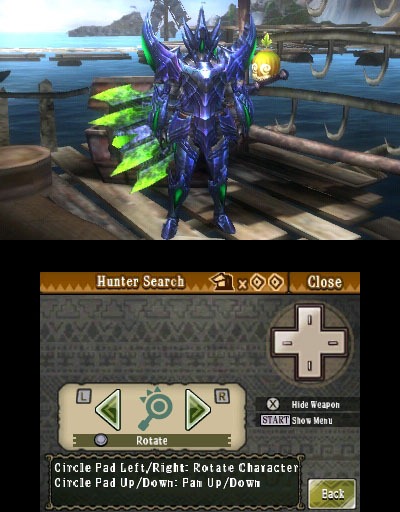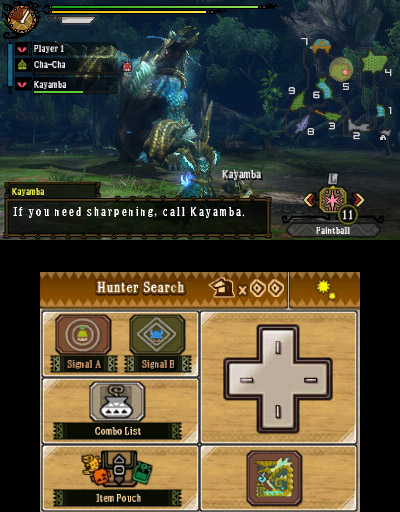Gorgeous level and monster designs; multiple layers of deep gameplay mechanics; lots of content; great local co-op play
Gameplay definitely lacks universal appeal; (essentially) no online play; slow to really get into the action
Allow me to join in the chorus of video game reviewers admitting that Monster Hunter 3 Ultimate is my first real trip into this Capcom franchise. I’ve flirted with the series a couple times and was close to taking the plunge when the game originally released on Wii, but never bothered to really invest the time into it. Then again, I think that’s how most of North America’s game playing public feels. Japan embraced the game, and when it finally jumped to handhelds it effectively became the PSP’s raison d’etre and the go-to time killer for millions. Reviewing Monster Hunter 3 Ultimate for 3DS is my excuse to finally give the game a chance and figure out what Japan sees in the franchise.
Interestingly enough, it didn’t take long for me to discover why Monster Hunter can be so popular to some and so hard get into for others. After you boot the game up and create your character you are thrown into a long series of tutorials breaking down the game’s many systems; though when you really look at it, most of the game can really be broken down to two simple elements: collecting and crafting. Collecting might be an over simplification, because that can mean picking herbs, mining for ores, or slaughtering creatures for their hides, bones, and other goodies. Then you take all the goodies and turn them into weapons, pieces of armor, creature bait, or maybe even cook them. For the plant life, you can even grow them at the local farm so you don’t have to worry about hunting for them in the wild.
Some will find this seemingly endless loop of collecting and crafting monotonous and repetitive and not want to invest any great amount of time into it. Thankfully there is the option to buy new weapons and armor, and while it might never yield the same level of satisfaction and power as the best weapons made from the hardest to obtain materials, it still allows them to progress. However, that is of course assuming they can appreciate the other major part of the Monster Hunter formula that can be equally divisive– the combat.

The first time I picked up a Monster Hunter game I actually found the hunting portion to be extremely clunky and frustrating; everything felt slow and shallow. However, after spending some serious time with MH3 I have come to the understanding the best description for it is “deliberate.” I don’t just mean that Capcom meant for the combat to feel this way, but that every action carries a very definite sense of weight and must be made with very clear intent. Most modern action games, like the Ninja Gaiden or Devil May Cry series, feature quick dodge or block maneuvers that can be instantly executed to break out of a combo to avoid incoming damage. In MH3U when you attack you are committed until the animation finishes or a monster knocks you off your feet. Some will think this hurts the flow of the game, but that’s where weapon selection comes into play.
With a dozen unique weapon types to choose from, MH3U actually presents a good amount of variety to the player willing to invest at least enough time to explore the options. You have fairly simple melee offerings like long swords and hammers, ranged weapons like bows, and the just plain weird like the gunlance or hunting horn. Most weapons have attacks mapped to the X and A buttons and some sort of special move attached to the R button, which can be another attack that can be used with the other buttons to generate simple combos or something completely different entirely. The hunting horn for example generates musical notes on the lower screen depending on which attacks you are using, and depending on the combo that is displayed at the time pressing R will create some sort of stat buff, like a increase to your attack or movement speed. Of course the different speed and damage stats also play a major role in spicing up the combat. If you find combat too slow, switch to the dual blades to launch a slew of fast but weak attacks, or if you aren’t afraid to leave yourself exposed as you wind up for slow but powerful swings, take the great sword out for a spin.
And that brings me to one of the more interesting things about this game– underwater combat. Seriously, how many games have made serious attempts at underwater melee combat? I don’t really know, but MH3U pulls it off amazingly well considering the circumstances. If you have the Circle Pad Pro, you should definitely use it as it makes the camera controls, which control your up and down pitch in the water, as easy as playing any other game from the last decade. However, the digital D-Pad you can place on the bottom screen works surprisingly well. It shouldn’t take too long to grow used to using it, and it sure beats reaching across the touch screen to use the actual D-Pad. And speaking of the touch screen, one of the features Capcom frequently talked about was the option the customize it, though I never really bothered to. As I said, the digital D-Pad works well, the ever present mini map is extremely useful, and having your health and stamina bars on there creates a seamless, HUD free top screen experience.

Considering the amount of effort that went into developing the core gameplay mechanics in MH3U, it is kind of surprising how bare bones the story is. It pretty much boils down to this: village has monster problem, you kill monsters for a living, you set out to kill villages monsters. There is a bit more to the proceedings than just this. Each of the game’s many, many quests features a little flavor text or some dialogue to give it some sense of purpose, but it all ultimately boils down to kill this monster or collect so many of that item. Yes, everything is geared toward reinforcing these key elements of the game, but it wouldn’t hurt to give the frequently epic battles a little more dramatic presence.
At least the game’s visuals do a good job of keeping you interested in the world and, if anything, I think the 3DS version kind of stands out a bit more than the Wii U game, and no that is not a 3D joke. Where the Wii U version can’t totally shake the fact that it is a Wii game with a 1080p facelift, MH3U is a great looking game on 3DS. While each level is divided up into relatively small chunks, the game is able to create a strong sense of place by giving every area some sort of unique feature, whether it be a sweeping panoramic vista over a valley stretching out to the horizon, or a beautiful waterfall feeding a river running through the stage. I’ve always enjoyed how 3DS enhances the sense of depth in large 3D environments, and MH3U fits the bill quite well, especially in the the underwater portions.
And then there is the other major feature to take into consideration as you decide whether or not to invest yourself in the Monster Hunter experience– the multiplayer. This is where the differences between the Wii U and 3DS versions really make themselves known, with the 3DS focusing on local play. In Japan this has been one of the series’ biggest strengths, because the dense population and prevalence of public transportation are perfectly suited for handheld multiplayer experiences. If you happen to live in a major metropolitan area this might apply to you as well, but in my little chunk of Midwest suburbia the opportunity for play with random players never presented itself. Regardless, the game is best enjoyed in a group, so if you can find friends with either version, you can join each other’s hunts, and the shared satisfaction of taking down massive monsters as a group truly is a great experience. Tragically, MH3U on 3DS doesn’t embrace online like the Wii U version; however, I can’t say it is completely lacking. If you own a Wii U Lan Adapter, you can actually download a Wii U app that will let you synch your game with your Wii U and join, but not create, online lobbies. It’s nice to have this option, but unfortunately I was unable to test it.
One could keep talking about Monster Hunter 3 Ultimate; it is undeniably a deep game with massive amounts of content that definitely has the potential to leave the right type of gamer hopelessly addicted. Then again, if the thought of hunting and scrounging for items to upgrade you gear in between epic battles to the death with massive creatures via very strict, unforgiving combat mechanics doesn’t tickle your fancy, then you’ll probably pass this game on by and be better for it. I personally fall somewhere in the middle, and even though I won’t be devoting my life to Monster Hunter I now have a much better understanding of the game and can’t deny it truly is a great game. Capcom set out to do something very unique with these games, and it has done a brilliant job crafting an amazingly designed game that is just as capable of engrossing gamers as it is alienating them.
So, if MH3U sounds like your cup of tea, there is one more question to ask: 3DS or Wii U? While you’ll have to read our separate review for the Wii U version to get the complete picture for that game, I feel the 3DS version makes a very strong argument for itself. The lack of dedicated online play really is a let down, but local play is still great, and the core premise of the game makes it great for portable play as you can limit your play to a quick run to gather supplies and slay a few monsters, or you can sit down for hours to tackle a few quests or take on some of the more time consuming boss fights. Furthermore, the game makes great technical use of the 3DS horsepower, and its environments benefit from the added depth. Then again, you could always buy both versions because there is the option to transfer your character back and forth so you can enjoy each system’s unique features.




 ShareThis
ShareThis






